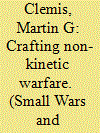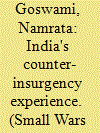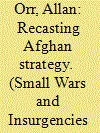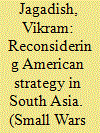|
|
|
Sort Order |
|
|
|
Items / Page
|
|
|
|
|
|
|
| Srl | Item |
| 1 |
ID:
091487


|
|
|
|
|
| Publication |
2009.
|
| Summary/Abstract |
This article examines the ways and means in which states employ irregular and indigenous personnel in a counter-insurgency (COIN) or counter-terrorist (CT) campaign, in the historical and contemporary context. The authors clarify the terminology surrounding this neglected area of COIN/CT theory, and identify four types of indigenous assistance - individual actors (trackers, interpreters, informers and agents); home guards and militias; counter-gangs; and pseudo-gangs. This article concludes that while the use of such indigenous irregulars has its advantages for the state and its armed/security forces (particularly as far as intelligence, local knowledge and undermining the insurgent's cause is concerned), it can also have serious practical and ethical implications for a COIN/CT campaign, and can have unexpected and unwelcome consequences including violations of laws of armed conflict, the undermining of governmental authority and the prospects of endemic internal strife and state collapse.
|
|
|
|
|
|
|
|
|
|
|
|
|
|
|
|
| 2 |
ID:
091499


|
|
|
|
|
| Publication |
2009.
|
| Summary/Abstract |
Written in response to the ongoing insurgencies in Iraq and Afghanistan, the new US Army/Marine Corps counterinsurgency manual reflects a unity of effort between the military and academic worlds rarely seen at the doctrinal or operational level. Because counterinsurgency operations are predicated upon an intimate understanding of human behavior as well as the social, economic, and political forces that can aggravate and encourage insurgents to take up arms against the standing authority, the American military has called upon scholars to lend their expertise towards developing nonmilitary or 'nonkinetic' prescriptions for battling 'internal' war over the years. Since the early 1960s many within the academic community have answered that call. Such participation, however, has sparked a bitter debate among members of both academe and the military. This article will examine the role that human rights advocates and social scientists have played in shaping counterinsurgency doctrine as well as the controversy this participation has produced both during the Cold War and today.
|
|
|
|
|
|
|
|
|
|
|
|
|
|
|
|
| 3 |
ID:
091489


|
|
|
|
|
| Publication |
2009.
|
| Summary/Abstract |
The Indian Army, a force trained primarily for conventional warfare, has been engaged in internal counter-insurgency operations since the 1950s. Despite such a long innings on a counter-insurgency mode, little attention has been accorded within military circles to doctrinal innovation for waging sub-conventional warfare in India's democratic political context. At best, the Army continues to view counter-insurgency duty as secondary to its primary duty of defending India from external conventional threats. By conceptualizing a counter-insurgency strategy of 'trust and nurture', this article aims to fill this critical doctrinal gap in India's military policy. The author argues that a counter-insurgency strategy of 'trust and nurture' based on democratic political culture, measured military methods, special counter-insurgency forces, local social and cultural awareness and an integrative nation-building approach will result in positive handling of India's internal security problems. The author utilizes India's counter-insurgency experiences in Assam, Mizoram, Nagaland, Punjab, and Operation 'Sadhbhavana' in Jammu and Kashmir as illustrative empirical indicants in order to validate the 'trust and nurture' strategy.
|
|
|
|
|
|
|
|
|
|
|
|
|
|
|
|
| 4 |
ID:
091498


|
|
|
|
|
| Publication |
2009.
|
| Summary/Abstract |
This paper examines whether non-lethal weapons (NLWs) enhance the capability of the US armed forces to conduct irregular warfare (IW) operations. With expectations that the operational environment will only continue to become more complex in the future, NLWs may reduce the level of violence received, as well as dispensed, by US forces while performing tasks in the IW spectrum. We argue that NLWs increase the ability of US forces to address the long tail of warfare and their deployment should be increased in the near term.
|
|
|
|
|
|
|
|
|
|
|
|
|
|
|
|
| 5 |
ID:
091491


|
|
|
|
|
| Publication |
2009.
|
| Summary/Abstract |
The following article aims to examine current counter-insurgency (COIN) strategy in Afghanistan to posit an untried theoretical concept of operations for the war being waged there. By doing so it shall argue that Coalition and NATO forces operating there may be required to fundamentally recast Afghan war-policy if a resurgent Taliban and Al-Qa'eda are to be countered in both the military and political spheres of present day Afghanistan. By way of strategy this article shall posit that a more optimal strategy in Afghanistan, in light of the campaign's apparent difficulties, might be to seed local security apparatuses, designated herein as 'Rural Paramilitary Forces'.
|
|
|
|
|
|
|
|
|
|
|
|
|
|
|
|
| 6 |
ID:
091488


|
|
|
|
|
| Publication |
2009.
|
| Summary/Abstract |
Over seven years after the 11 September 2001 attacks on the United States, Afghanistan is again at the forefront of the headlines, faced with a brutal insurgency and a resurgent Taliban. Many scholars and policymakers attribute the instability in Afghanistan to a terrorist sanctuary in the neighboring Federally Administered Tribal Areas (FATA). Pakistan has attempted to eliminate this sanctuary through negotiation and armed force. This paper argues that Pakistani strategy has failed to achieve its desired results because of local tribal norms, the weak nature of previous agreements, military units ill-equipped for a counterinsurgency and counterterrorism role, as well as ideological fissures in the Pakistani establishment. Afterward, the paper argues that the United States and Coalition forces should pursue their strategy remaining cognizant of local tribal norms, step up training efforts for Pakistani forces, promote development of the tribal areas, and cultivate options for eliminating the FATA sanctuary through covert means.
|
|
|
|
|
|
|
|
|
|
|
|
|
|
|
|
| 7 |
ID:
091492


|
|
|
|
|
| Publication |
2009.
|
| Summary/Abstract |
This article had its genesis in a background study for the development of a new Australian Army counter-insurgency doctrine. Archival research showed that the Australian counter-insurgency doctrine employed in such post-1945 conflicts as Burma, Malaya, Borneo and Vietnam originated in the jungle campaigns of the South West Pacific Area during World War II. The historical record also showed that the Army's counter-insurgency doctrine, as with its World War II-jungle warfare doctrine, was a pragmatic amalgam of Australian experience and British doctrine. The article traces this process through the development of a series of doctrine manuals. It also considers the contribution of key individuals to both counter-insurgency theory and practice. This distinctively Australian approach to the development of doctrine was responsible for producing a highly successful manual, The Division in Battle: Pamphlet No. 11, Counter-Revolutionary Warfare (DIB 11), which the Army used during its involvement in Vietnam.
|
|
|
|
|
|
|
|
|
|
|
|
|
|
|
|
|
|
|
|
|